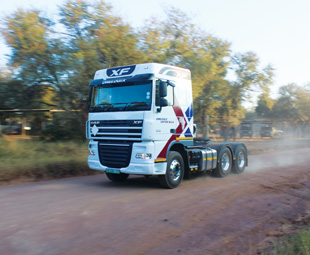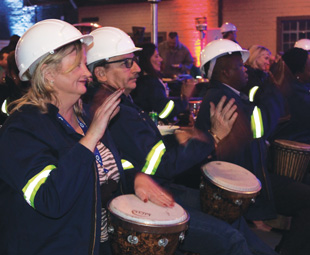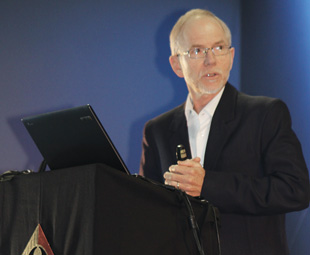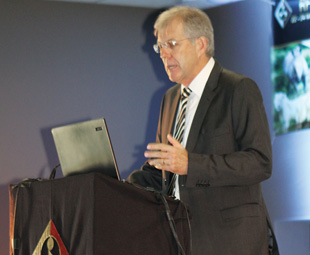Trouble on the horizon?

Certain key themes cropped up at the 2016 Road Freight Association (RFA) Convention, reports GAVIN MYERS. In addition to debate on policies that will affect the industry, economic, labour and safety concerns crept in
In 2015, trucks moved 1 450-million tonnes of bulk commodities (20-million tonnes of this was moved by truck due to a lack of rail services). The industry employs 130 000 people, while a contribution of roughly seven to eight percent of gross domestic product (GDP), amounting to R130-million rand, is made by deliveries by operators transporting for gain, financing from banks and fuel purchases.
This is the picture of the South African road transport industry painted by Sharmini Naidoo, CEO of the RFA. On the face of it, the numbers are quite promising.
 Naidoo warns, however, that operators could see themselves in severe difficulty due to: the draft BB-BEE code for the road freight industry; steps that are being taken to move trucks off the road; the introduction of the Administrative Adjudication of Road Traffic Offences (Aarto) Act, which will open a whole new can of worms; and the fact that artificial measures, which will make road freight less attractive and more expensive, are afoot.
Naidoo warns, however, that operators could see themselves in severe difficulty due to: the draft BB-BEE code for the road freight industry; steps that are being taken to move trucks off the road; the introduction of the Administrative Adjudication of Road Traffic Offences (Aarto) Act, which will open a whole new can of worms; and the fact that artificial measures, which will make road freight less attractive and more expensive, are afoot.
The RFA Convention 2016 set out to draw attention to these concerns and educate operators about the threats facing their businesses.
Minister of Transport, Dipuo Peters, delivered the keynote address. Regarding overloading, the minister noted that not enough is being done to address the issue.
“Overloading is severe; sometimes up to and over 100 percent, with some operators budgeting for admission of guilt fines. Damage to roads costs the economy billions of rand. This cannot continue unpunished and has to stop … self regulation is crucial. Implementing the Road Traffic Management System (RTMS) shows you have nothing to hide and don’t want to be policed – that is what we want.”
 Regarding road to rail, she stated: “Department of Transport policy is driven through the national freight logistics policy, which aims to ensure effective and efficient movement of goods with a balance between road and rail.
Regarding road to rail, she stated: “Department of Transport policy is driven through the national freight logistics policy, which aims to ensure effective and efficient movement of goods with a balance between road and rail.
“Cargo that is not time-sensitive should be moved to rail – we are still engaging with those who have concerns. It’s not about which mode is correct – road will always be there – an integrated approach does not allow one to be better than the other,” she emphasised.
So far so good (somewhat), but then the minister struck a nerve. “The Department, in close cooperation with provincial traffic authorities, is currently developing the national road safety strategy. Interventions include peak operating time restrictions [an issue of great concern at the 2015 RFA Convention, still open for comment – ed.], tightening of roadworthy testing, raising the standard of professional driving permits, and implementing legislation to deal with fatigue management,” she noted, before pulling out her truck-shaped salt shaker …
 “A key recommendation from our freight strategy is the establishment of a single transport economic regulator. A draft bill has been completed and the medium-term target is to establish it through the relevant legislation by December 2016.
“A key recommendation from our freight strategy is the establishment of a single transport economic regulator. A draft bill has been completed and the medium-term target is to establish it through the relevant legislation by December 2016.
“We believe the regulator will help us deal with the freight sector – establishing appropriate institutional and regulatory structures to prevent pricing abuse in captive markets – and ensure fair conditions for intermodal competition.”
When questioned from the floor as to the strategic rationale of the permit system, the topic was somewhat brushed off: “Has deregulation assisted us to get where we want to be? Our challenge has been to accurately get road-freight information.
“This must be a matter of discussion to better manage road freight; we want to try to regulate the transport fraternity and know what is moving on the road. The idea is to be able to issue a permit to a particular vehicle transporting a particular cargo on a particular corridor.”
 Troubled times ahead? “Penalising an industry that adds so much value is an injustice …” scorned Naidoo. “The industry is not acknowledged for its contribution and true worth. It has taken many years for the industry to fine tune its processes in order to deliver slick and professional services.”
Troubled times ahead? “Penalising an industry that adds so much value is an injustice …” scorned Naidoo. “The industry is not acknowledged for its contribution and true worth. It has taken many years for the industry to fine tune its processes in order to deliver slick and professional services.”
Here’s hoping no irrational decisions that could change that for the worse are pushed through unchecked.
Labouring over labour
Labour issues in South Africa are nothing new. However, according to Ian Macun – director of collective bargaining at the Department of Labour – folks in the transport and logistics sector might have to get used to some different scenarios in future.
Is that a good thing? Well, it depends … Macun began: “There are certainly a lot of problems in our labour relations and bargaining; violence, economic impacts, short-termism. We are examining ways of strengthening collective bargaining to stabilise labour relations and affect behaviour in conflict resolution and strike action. This would no doubt have a positive effect on collective bargaining.”
According to Macun, the number of South African bargaining institutions declined between 1992 and 2014 from 87 to 44. However, employee coverage went up from 735 000 to 2,5 million, which would suggest an increase in collective bargaining activity. During 2015, the private sector bargaining councils covered 1,4 million employees, while those in the public sector covered 1,1 million.
 “Coverage has risen more rapidly in the public sector, while the private sector has been more stable,” Macun added.
“Coverage has risen more rapidly in the public sector, while the private sector has been more stable,” Macun added.
The manufacturing sector is key; employing some 1,75 million people, represented by 17 councils that cover 36 percent of the workforce. The transport sector employs 922 000 people, represented by three councils with a 22-percent coverage.
Regarding representativeness of councils, the road freight trade unions make up 45-percent coverage, with employer representation at 43 percent. In the Motor Industry Bargaining Council the numbers are 36 and 61 percent respectively.
“Compared to international trends, our policy environment for collective bargaining is pretty stable and likely to remain so with one big exception: the possible introduction of the national minimum wage,” Macun noted.
This, he said, is a real unknown. “It’s not a question of if, but, rather, of when. It might not be a bad thing, depending on how we set it and what the exemptions are, but for the future of collective bargaining this will be the big issue.
“If we land up with high minimum wages it will undermine sector-level arrangements currently negotiating lower minimum-wage levels, and it could destabilise institutions. If it is instituted, most unions could ‘sit back’.”
 What are the likely future scenarios for public-sector collective bargaining? Macun discussed two possibilities. “Some feel there could be growth in collective bargaining, but I think it’s unlikely in the short to medium term. What concerns me is the scenario of decline.”
What are the likely future scenarios for public-sector collective bargaining? Macun discussed two possibilities. “Some feel there could be growth in collective bargaining, but I think it’s unlikely in the short to medium term. What concerns me is the scenario of decline.”
In such a scenario, the first indicator will be a weakening on the part of the trade union movement. A second is employer resistance. Third would be a move to plant-level bargaining, (mining is a key example). The final factor in this scenario would be a weakening of bargaining councils as institutions and an inability to perform their duties.
“A more positive scenario would be the continuation of collective bargaining,” suggested Macun. “Collective bargaining would need to retain its present coverage and that could require strengthening through the amalgamation of councils. Coverage could then increase, but would not be substantial. For bargaining just to continue will require support and action by all players.”
“I sincerely hope that in the Road Freight Bargaining Council there will be a commitment to a continuation scenario to the point where the minister has no discretion. The ball is in your court to get the levels up to that point,” he concluded.
Making safety a certainty
In the trucking industry, safety is an issue that requires much attention. As Sharmini Naidoo, CEO of the RFA, stated: “Truck accidents amounted to only 4,8 percent of the total accidents over the 2015 December holidays – but their impact, to both operators and other road users, is much bigger. Every accident reported damages the industry’s credibility.”
 Con Roux, commercial manager at the N3 Toll Concession (N3TC), spoke about how accidents affect the efficiency of the N3. He was joined by Tom Halliwell, CEO at Libra Brokers, who spoke about how managing risks – such as driver fatigue – can reflect meaningfully on the bottom line.
Con Roux, commercial manager at the N3 Toll Concession (N3TC), spoke about how accidents affect the efficiency of the N3. He was joined by Tom Halliwell, CEO at Libra Brokers, who spoke about how managing risks – such as driver fatigue – can reflect meaningfully on the bottom line.
The N3 is South Africa’s busiest leisure and economic corridor, and the N3TC’s role is to finance, design, construct, operate and maintain the route. Up to 40 000 vehicles use the route on peak days, of which heavy vehicles account for 35 percent. Yet fatalities on the route decreased by 43 percent between 2011 and 2015.
“Road safety is a brute of a problem … one crash can change all the progress made,” he added.
To illustrate his point, Roux referred to a small crash on Van Reenen’s pass, which, alone, was estimated to cost the economy R15 million. “I believe, however, that one of the biggest costs of crashes is the reputational cost to the industry and consequent failure to attract suitable entrants.”
Roux elaborated with an anecdote about a student he lifted from Van Reenen to Harrismith, who commutes every day by hitching a lift with trucks. “He said that, without fail, every time he talks to a driver they tell him they fear for their life every time they drive. This is morally indefensible.”
Roux noted that 73 percent of crashes on the route are due to human factors, including distraction and fatigue.
“Fatigue is more serious than we think,” said Halliwell, explaining that 84 percent of the rand value paid out by Libra was made up by “own damage” claims, implicating a driver. Fatigue was the largest contributing risk element of those claims; accounting for 35 percent.
 It would stand to reason that reducing fatigue will substantially lower insurance claims and the knock-on effect of higher premiums and vehicle downtime. To prove the point Halliwell discussed a case study undertaken with a Libra client.
It would stand to reason that reducing fatigue will substantially lower insurance claims and the knock-on effect of higher premiums and vehicle downtime. To prove the point Halliwell discussed a case study undertaken with a Libra client.
Between 2012 and 2015, the client’s claims grew from around R1 million to R11 million. Similarly, its insurance on goods in transit grew from nearly R500 000 to almost R7 million in the same period.
A risk assessment was undertaken and a risk management programme implemented. All trucks were grounded from 22:00 to 04:00; the salary structure changed for new drivers; the employment process was upgraded; and 24-hour monitoring (including speeding) was implemented.
The results, explained Halliwell, were immediate. “With the risk management programme we only focused on fatigue. The claims loss ratio went from 235 percent (horrific for any insurance company) to 42,3 percent after only four months.”
With the N3TC continuing its good work, and more fleets taking risk management as seriously as Libra has illustrated, we can only hope that the credibility of the trucking industry will one day be restored.
What about the money?
“Who’s in business to lose money?” asked economist, Mike Shussler as he painted a rather bleak picture of the current local economic situation. Shussler was joined by investment economist at PSG Capital, Dawie Klopper, who added more from a global perspective.
Both speakers echoed a humbling sentiment – global economies and equity markets are struggling, and the knock-on effect in South Africa (combined with our own economic maladies) is not particularly rosy.
 “Last year saw the quickest drop in commodity prices since 1932; prices of free-market commodities are at a 42-year low … World commodities are on downward trend and it’s not good for South Africa,” commented Shussler.
“Last year saw the quickest drop in commodity prices since 1932; prices of free-market commodities are at a 42-year low … World commodities are on downward trend and it’s not good for South Africa,” commented Shussler.
What are some of the causes? A primary factor is the sheer amount of uncertainty in the world. Global socio-political tension (for example, migrants into Europe, elections in the United Sates (US) and the threat of ISIS) together with concerns about growth in US, China and Europe are foremost.
Said Klopper: “The International Monetary Fund (IMF) has reduced its growth forecast around the world. America’s predicted growth is at 2,6 percent. Growth in China has also slowed. China has overinvested in infrastructure, so does not have a big demand for commodities, pushing the decline in commodity prices.”
Shussler added: “There is a major disconnect between production levels and prices at the moment. There is too much steel and too much oil … the world has 50 days of oil production in storage.
“Gas, solar and wind power are cheaper (and cleaner) than coal – the demand of oil and coal for electricity generation is in decline. Coal isn’t coming back; commodity structures are changing.”
 We’re already seeing such effects locally and in the transport industry, noted Shussler. “Road transport is under pressure and has been in decline for ten months. Ports and bulk commodities are down 5,8 percent since September; iron ore and coal are projected to drop, which will affect rail and ports profits. Rail payload is experiencing its biggest decline in the last 15 to 20 years.
We’re already seeing such effects locally and in the transport industry, noted Shussler. “Road transport is under pressure and has been in decline for ten months. Ports and bulk commodities are down 5,8 percent since September; iron ore and coal are projected to drop, which will affect rail and ports profits. Rail payload is experiencing its biggest decline in the last 15 to 20 years.
“It’s no wonder Transnet wants to push into fast-moving consumer goods and the permit system is on the cards – rail is under severe pressure and profits need to be protected!” he exclaimed.
Is it all bad news? Can the South African economy recover? Shussler was soberingly realistic: “The next five years are going to be hard – for most industries the focus will be more about keeping jobs than creating them. Our growth in gross domestic product (GDP) forecast is between 0,4 and 2,6 percent by 2018.”
This is worrying when unemployment is already severe at 25,4 percent. “Targets set in the 2016 budget must be achieved. It will be tough, and if we don’t succeed a downgrade will be a possibility. However, I am confident the rand can strengthen again,” noted Klopper.
Shussler’s conclusion? Success is not impossible. “A crisis is what gets one working on a solution, forces us to face facts and to talk. Part of the solution will be to ‘get real’ … One only addresses structural problems when under pressure. Things will get better.”

Published by
Focus on Transport
focusmagsa




